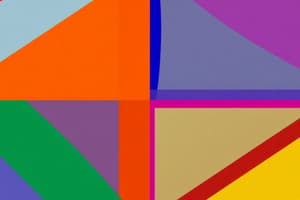Podcast
Questions and Answers
What is the defining property of a rectangle?
What is the defining property of a rectangle?
- All sides are equal
- All angles are right angles (correct)
- Opposite sides are equal
- All angles are acute angles
Which type of quadrilateral always has congruent sides and congruent angles?
Which type of quadrilateral always has congruent sides and congruent angles?
- Parallelogram
- Square (correct)
- Rhombus
- Trapezoid
What is the sum of all interior angles in a quadrilateral?
What is the sum of all interior angles in a quadrilateral?
- $360^\circ$ (correct)
- $180^\circ$
- $270^\circ$
- $450^\circ$
In a parallelogram, what can be said about opposite sides?
In a parallelogram, what can be said about opposite sides?
What is the special characteristic of the diagonals in a rectangle?
What is the special characteristic of the diagonals in a rectangle?
Which quadrilateral has exactly one pair of parallel sides?
Which quadrilateral has exactly one pair of parallel sides?
What is the defining property of a parallelogram?
What is the defining property of a parallelogram?
How can you determine the area of a parallelogram?
How can you determine the area of a parallelogram?
What happens if two diagonals inside a quadrilateral are both perpendicular to each other and equidistant from its sides?
What happens if two diagonals inside a quadrilateral are both perpendicular to each other and equidistant from its sides?
Which method can be used to calculate the area of an arbitrary quadrilateral?
Which method can be used to calculate the area of an arbitrary quadrilateral?
What do the midpoints of both diagonals in a quadrilateral form when connected?
What do the midpoints of both diagonals in a quadrilateral form when connected?
In a parallelogram, what happens when any segment is drawn within it?
In a parallelogram, what happens when any segment is drawn within it?
Study Notes
Quadrilaterals
Quadrilaterals are two-dimensional shapes formed by connecting four points called vertices, with their edges referred to as sides. These flat figures have intriguing properties that make them fascinating objects of study within geometry. Let's explore some important aspects of quadrilaterals, starting with their various forms and moving on to properties, diagonal behavior, and specific cases like parallelograms.
Types of Quadrilaterals
A quadrilateral can vary depending upon its vertex angles, side lengths, and parallel relationships between adjacent sides:
- A rectangle is a special type of square with opposite sides being equal and all interior angles measuring (90^\circ) each.
- A square is a rectangle whose sides have the same length and all internal angles equaling (90^\circ).
- An oblique (or irregular) quadrilateral does not possess any additional characteristics beyond having distinct angles and edge lengths.
- Other named quadrilaterals exist based on angle properties or congruent sides, such as squares, rectangles, rhombi (equilateral quadrilaterals), trapezoids, kites, and parallelograms.
Properties of Quadrilaterals
Regardless of their shape, every quadrilateral has some common features:
- Each vertex lies at precisely one intersection point where three other lines meet.
- Every quadrilateral contains exactly four sides and four vertices.
- All interior angles found within the shape sum up to (360^\circ).
Diagonals of Quadrilaterals
Diagonals, which join nonconsecutive vertices, play essential roles when examining certain properties of quadrilaterals:
- In general, finding the midpoints of both diagonals will result in another set of intersecting points known as the orthogonal (right) bisectors.
- If two diagonals crossing inside a quadrilateral are perpendicular and equally spaced from its sides ((90^\circ) angles formed between these diagonals and the sides they cross), we call it a parallelogram.
Area of Quadrilaterals
Calculating the areas of quadrilaterals varies according to the specific form of the shape; however, here are some fundamental concepts behind determining the area of quadrilaterals:
- For any arbitrary quadrilateral, you could create two triangles by drawing diagonals through one pair of opposite vertices. Finding the areas of those triangles gives us the quadrilateral's area using Heron's formula or the half-perimeter method.
- For a parallelogram, calculating its area is straightforward since it is simply twice the product of base length and corresponding height.
- Rectangular (and square) quadrilaterals, due to their simple structure, present even more direct methods for computing their respective areas.
Parallelograms
As mentioned earlier, parallelograms gain attention because of their unique property involving the equal distance relationship among their diagonals, vertices, and line segments drawn within them. Consequently, there are several exciting facts and applications associated with parallelograms:
- Opposite side lengths are congruent.
- Any given segment drawn within a parallelogram bisects the opposite side into segments proportional in length to the entirety of the remaining sides.
- Parallel lines of reflection preserve its shape and size, providing symmetry.
Understanding these basics of quadrilaterals sets the foundation required for advanced geometrical explorations. As a student or enthusiast of math, expanding your knowledge of quadrilaterals opens doors to comprehending more complex shapes while reinforcing basic geometric principles and fostering problem-solving skills.
Studying That Suits You
Use AI to generate personalized quizzes and flashcards to suit your learning preferences.
Description
Delve into the intriguing world of quadrilaterals, two-dimensional shapes defined by four vertices and their connecting sides. Learn about the various types of quadrilaterals, their properties, diagonal behavior, and specific cases like parallelograms. Understanding these fundamental concepts is essential for advanced geometrical explorations.




